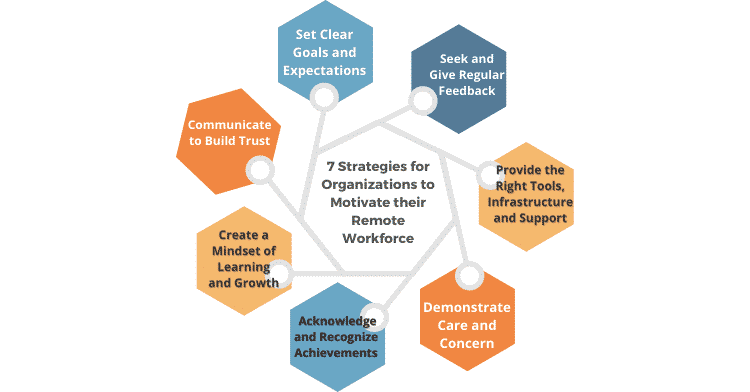1. Set Clear Goals and Expectations: Define tasks, priorities, deadlines, and communication methods to provide a transparent work environment and help employees understand what is expected of them.
2. Provide the Right Tools and Support: Ensure employees access necessary tools, infrastructure, and technical support, including communication and project management tools, ergonomic equipment, and fast internet connections.
3. Foster a Learning and Growth Mindset: Create opportunities for continuous learning through online training, self-learning modules, and challenging projects that expand employees’ skill sets.
4. Demonstrate Care and Concern: Show empathy by offering flexible work schedules, wellness programs, and support for employees’ personal and family needs.
5. Communicate to Build Trust: Communicate updates regularly, listen to employees’ ideas and concerns, and take action to assure them that they are valued and integral to the organization.
6. Acknowledge and Recognize Achievements: Use digital platforms for employee recognition to appreciate and motivate employees for their contributions and enable peer-to-peer recognition.
7. Seek and Give Regular Feedback: Regularly seek and provide feedback to understand needs, improve coordination, and build trust between employees, managers, and the organization.
Most organizations struggle to motivate their remote workforce. However, they fully understand the need for a motivated and engaged workforce to drive business growth and profitability despite challenging market conditions.

There are several challenges associated with managing and motivating remote employees.
One of the biggest challenges of motivating remote employees is the lack of proper, timely, and clear two-way communication between employees and their supervisors as well as between co-workers.

This results in unclear goals and priorities, lack of sharing of important information, poor coordination, lack of inputs and feedback, and eventually poor trust levels, disengagement, and isolation of remote workers.
Read 5 Effective Tips for Remote Management of Teams
Given that work from home or remote working is here to stay for a long time, organizations must understand how to motivate their remote workforce effectively.
Discussed below are seven strategies for organizations to motivate their remote workforce and keep them productive and engaged:
1. Set Clear Goals and Expectations
2. Provide the Right Tools, Infrastructure and Support
3. Create a Mindset of Learning and Growth
4. Demonstrate Care and Concern
5. Communicate to Build Trust
6. Acknowledge and Recognize Achievements
7. Seek and Give Regular Feedback


Organizations should establish the expectations they have for their remote-working employees.
These expectations should include tasks, priorities, deadlines, availability for meetings, and even their communication and feedback methodologies.
Hence, managers and supervisors in the organization need to be trained and coached to create a clear and transparent work environment without any ambiguity.
Knowing what is expected of them helps employees plan their work and deliver accordingly.
It gives them a sense of achievement/ fulfillment to complete the expected work.

The lack of proper work tools such as communication, collaboration, and project management tools required by the employees can severely impact the ability of the employees to deliver on the work assigned to them.
This, in turn, can impact their productivity and motivation.
Hence, facilities required by remotely working employees should extend to even workstations, ergonomic seating, and even a fast internet connection.
Organizations also need to provide remote technical support for hardware and software issues that the employees may face.
Read 7 Ways HR Software Can Support Your Remote Workers

The organization must create a virtual work environment that stimulates learning and growth for remotely working employees.
Hence, a combination of live online training sessions, self-learning modules, and on-the-job learning can prove to be effective.
Additionally, employees should be assigned projects and tasks that require them to expand their skill sets.
This encourages them to focus on improving their performance and efficiency.

Organizations should demonstrate care and concern for their employees during these challenging times to build trust and commitment.
Thus, in this current pandemic situation, employee and family wellness plans are great ways for organizations to show that they care.
Other initiatives can include flexible work schedules to enable remote employees to care for ailing or elderly family members.
Read Employee Wellness Ideas for Work from Home

Additionally, remotely working employees often feel isolated if they are not communicated with properly.
Hence, managers and supervisors need to assure employees that their ideas, opinions, and concerns are important for the organization.
Therefore, they must share essential updates, listen, and take requisite action.
This helps build trust with the employees as they feel an integral part of their organization.
Read: Peer-to-Peer Recognition – Understanding the Nuts and Bolts

Appreciating remote working employees for their excellent work and dedication is another effective way to motivate them.
Being recognized assures the employees that their work is being valued and that they are making a positive contribution to business growth and success.
Managers and supervisors should leverage digital employee recognition platforms to recognize their team members.
Organizations should also enable peer-to-peer recognition through these platforms.
Read Importance of Employee Recognition during difficult times

Seeking and giving feedback can be very helpful in keeping employees motivated, especially when they are working remotely.
Such feedback enables both the managers and the employees to understand the needs of one another and thus work together in a more coordinated manner.
Regular feedback also helps build trust levels with the supervisors and the organization.
Therefore, employee pulses and surveys can help organizations get regular feedback from remotely working employees.
Read Work from Home Might be the New Normal Post-COVID
These are the 7 strategies for organizations to motivate remote workforce and get higher employee productivity and performance, which in turn can help in business growth during these challenging times.

Lead author: Sagar Chaudhuri, the Co-Founder and CEO of HiFives. He is an HR Tech Evangelist with over 25 years of corporate and entrepreneurship experience. In the past, Sagar has worked in leadership roles with companies such as Genpact, Infosys, and ICICI Bank. He has an engineering degree from IIT Kharagpur and an MBA from IIM Lucknow. Connect on LinkedIn
To stay updated on the latest HiFives blogs, follow us on Twitter (@MyHiFives)